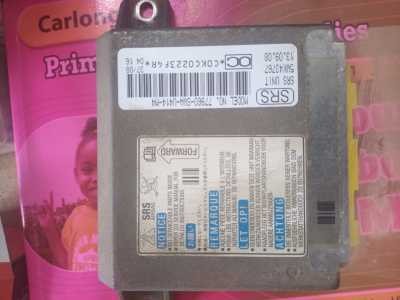Experiencing issues with your Honda CR-V’s safety restraint system (SRS)? A common trouble code that might surface during an OBD2 scan is B1187. This code, specifically “Gauge Control Module Lost Communication with SRS Unit,” indicates a communication breakdown within your vehicle’s critical safety network. Let’s delve into understanding this code, troubleshooting steps, and potential solutions, especially if you’re facing similar symptoms in your 2009 Honda CR-V.
Understanding OBD2 Code B1187: Lost Communication with the SRS Unit
The DTC B1187 signifies that your Honda’s gauge control module, which is responsible for displaying warnings on your dashboard, is unable to communicate with the Supplemental Restraint System (SRS) unit. The SRS unit is the central computer that manages your vehicle’s airbags, seat belt pretensioners, and related safety features. This communication loss can trigger warning lights and disable vital safety systems.
Symptoms associated with a B1187 code can include:
- SRS Airbag Light Illuminated: This is a primary indicator of a problem within the SRS system.
- Seat Belt Warning Light Malfunction: The seat belt light on the dashboard may not illuminate even when the seat belt is unbuckled.
- No Seat Belt Warning Chime: The audible warning that usually sounds when driving without a seatbelt may be absent.
These symptoms point towards a potentially serious issue where the SRS system’s functionality is compromised. Driving with an active SRS warning light means your airbags and seat belt pretensioners might not deploy correctly in an accident, increasing the risk of injury.
Troubleshooting Steps for a Honda CR-V with B1187
Diagnosing a B1187 code requires a systematic approach. Here are troubleshooting steps, drawing from a real-world experience with a 2009 Honda CR-V:
-
Initial Checks: Fuses and Seat Belt Buckle:
Start with basic checks. Inspect the fuse box, particularly fuse slot 11 (typically a 10A fuse in Honda CR-Vs), which is often related to the SRS system. A blown fuse can interrupt power supply. Also, check the driver’s side seat belt buckle for any obvious damage or malfunction.An example of a Honda CR-V fuse box, highlighting the importance of checking relevant fuses for SRS system issues like OBD2 code B1187.
-
OBD2 Scan and Code Clearing Attempts:
Use an OBD2 scanner to read and record all diagnostic trouble codes present. Attempt to clear the B1187 code. If the code returns immediately or cannot be cleared, it indicates a persistent problem. In some cases, other related codes like B1906 (“Air Bag Crash Sensor #2 Feed/Return Circuit Short to Ground”) might appear, offering further clues. -
Power Cycle (Battery Disconnect):
A simple system reset can sometimes resolve temporary glitches. Disconnect both battery terminals for an extended period (e.g., overnight or a couple of hours). This forces a reset of the vehicle’s electronic control units, including the SRS module. After reconnecting the battery, re-scan for codes. If B1187 persists, further investigation is needed. -
Investigating Communication Failure:
If the scan tool reports “no communication from the SRS system,” it confirms a deeper communication issue. This could stem from:- Wiring Problems: Faulty wiring, loose connections, or damaged harnesses between the gauge control module and the SRS unit are common culprits.
- SRS Module Malfunction: The SRS module itself might be defective and unable to communicate.
The location of the SRS module in a Honda CR-V, a key component to inspect when troubleshooting OBD2 code B1187 related to SRS communication issues.
-
Component Disconnection (Advanced Troubleshooting):
- Airbag and Seat Belt Connections: Carefully disconnect and reconnect the wiring connectors for airbags (steering wheel, passenger dashboard), seat belt pretensioners, and crash sensors. Ensure connections are clean and secure. Caution: Always disconnect the battery and wait for a period before working on airbag systems to prevent accidental deployment.
- SRS Module Connectors: Access the SRS module (typically located under the dashboard). Inspect and reseat all connectors to the module, ensuring a firm connection.
If, even after these steps, communication with the SRS module remains lost, it strongly suggests a faulty SRS module or a more complex wiring issue.
Potential Solutions and Further Diagnosis
Resolving a B1187 code often requires professional diagnosis, especially if basic troubleshooting steps are unsuccessful.
- Professional Scan and Diagnosis: A qualified mechanic with advanced diagnostic tools can perform in-depth scans, pinpoint wiring faults, and test the SRS module’s functionality.
- Wiring Repair: If wiring issues are identified, professional repair or replacement of damaged harnesses is necessary.
- SRS Module Replacement: If the SRS module is diagnosed as faulty, replacement is usually required. Ensure the replacement module is compatible with your vehicle (same year, make, and model). Note: SRS module replacement may require programming or coding to the vehicle.
Is Resetting Possible? While some minor electronic glitches can be resolved with a system reset (battery disconnect), a persistent B1187 code usually indicates a hardware or wiring problem that cannot be simply “reset.”
Seeking Professional Help: Due to the safety-critical nature of the SRS system, it’s highly recommended to consult a qualified automotive technician for diagnosis and repair of a B1187 code. Attempting to bypass or disable SRS components is dangerous and illegal.
By understanding the nature of OBD2 code B1187 and following a structured troubleshooting process, you can effectively address SRS communication issues in your Honda CR-V and ensure your vehicle’s safety systems are functioning correctly. Remember, prioritizing safety and seeking professional help when needed is crucial for SRS system repairs.
